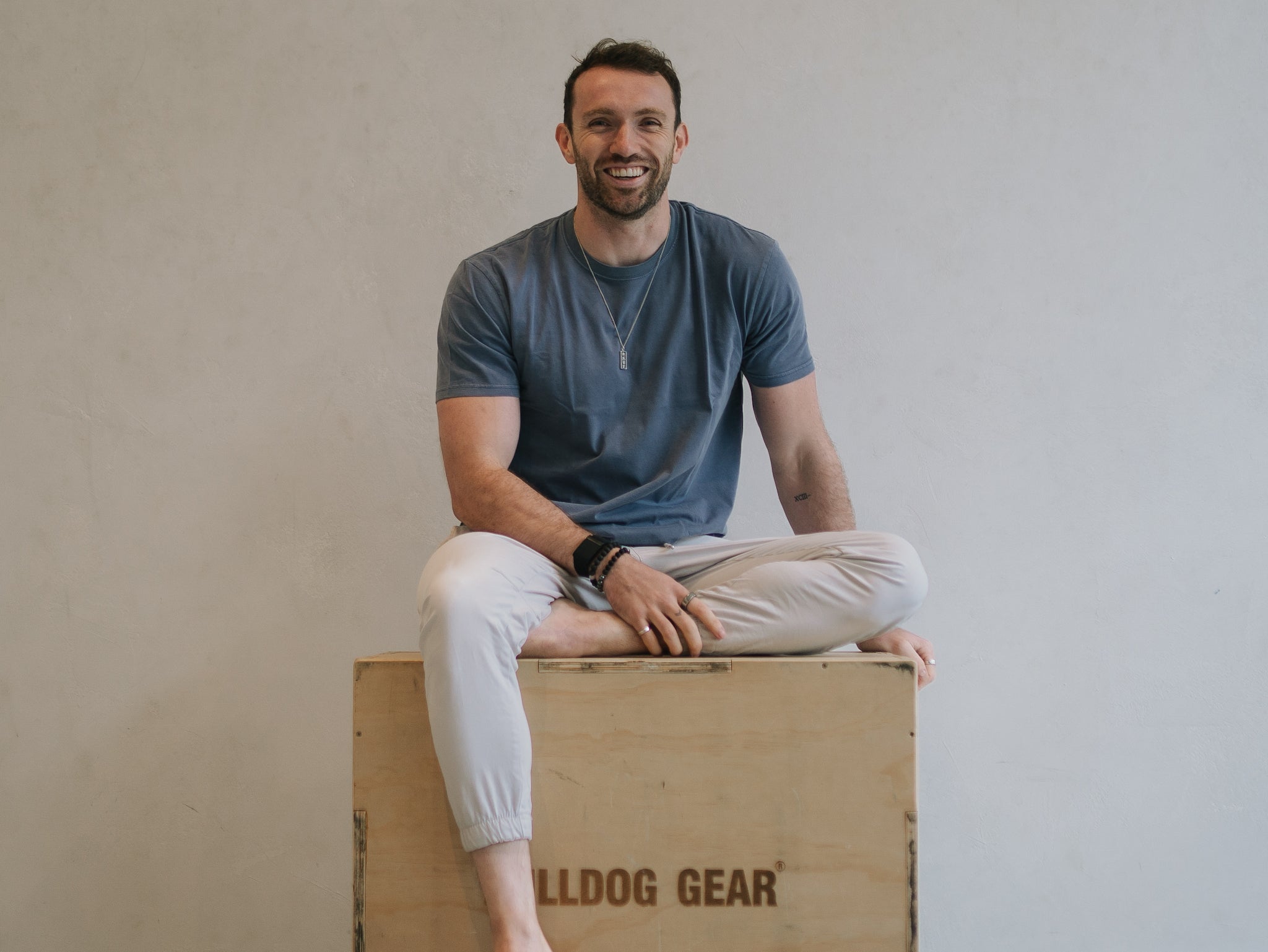As a breathwork coach, Jamie Clements founder of The Breath Space often hears a familiar line: “I can’t be breathing wrong because I’m alive.” And while technically true, he says it misses the point. “Yes, we’re all breathing in a way that keeps us alive,” he tells me. “But doing it a little bit better would do us some good.”
After just five minutes of guided breathwork with Clements, I get it. That tight feeling I’ve been carrying in my chest all day softens, my thoughts are locked in on the breaths I’m taking and I can visualise, strangely, shades of purple behind my closed eyes. When I open them, something has shifted. It’s subtle, but I can feel it.
That shift, he says, is exactly what breathwork is meant to offer. It’s a conscious recalibration of something we do all day without thinking. But as the practice gains traction in the wellness world, and TikTok algorithms churn out breathing “hacks” by the hour, many struggle to understand how this practice fits in with our day-to-day lives.
The principles of breathwork
“‘The breath’ is really this catch-all umbrella term that over the last five to 10 years, particularly in the UK and Western society, has come to encapsulate any way that we can use our breath to shift our state and work with how we think, feel and operate on a physical level, mental level, emotional level and spiritual level,” Clements tells me.
To cut through the noise, he’s developed a framework that helps people understand the practice without feeling overwhelmed. “I teach breathwork in three pillars,” he says. This approach is accessible – the idea is that we can all start somewhere.
The first, and most foundational pillar, is what Clements calls functional breathing. “How we breathe moment to moment, unconsciously, throughout the day. Can we improve, not perfect, our default patterns to support better health?” he asks. “It’s less about mastering a technique and more about unlearning habits that might be quietly taxing our systems, like mouth breathing or shallow chest breathing.”
The second pillar is what many people think of when they hear the word ‘breathwork’ – nervous system regulation via intentional exercises with the breath. This includes everything from box breathing to alternate nostril breathing, deliberate patterns that shift how we feel.
Read more: How to spot the symptoms of burnout and treat them, according to wellbeing experts
“This is what I believe most people think of when they hear ‘breathwork’, which is breathing techniques for a specific outcome. So changing the speed, depth, rhythm and ratio of the breath in a certain way with a desired outcome in mind,” says Clements.
“You can use the breath like an accelerator or a brake. Speed it up to boost focus and energy. Slow it down to calm the nervous system. It’s breathing with intent.”
The third pillar is where breathwork becomes transformational. This is where Clements says we can access altered states of consciousness, process trauma and explore emotional healing. It’s powerful terrain, and not without risk.
“This part of the work can bring up a lot. It requires care. It’s not something to dabble in lightly,” he says. “But it’s also where the biggest shifts can happen.”

The benefit of the breath
He speaks from experience. The practice of breathwork didn’t come to him as a hobby or curiosity. It came as a lifeline.
“I found breathwork at a time when I was really struggling with depression, anxiety and panic attacks. It wasn’t overnight, but over time, my life changed. And it’s still changing. That’s the thing with this work, it evolves as you do,” he tells me.
He recalls his first breathwork class, seven years ago. “That class changed everything. My teacher is someone that I have always looked up to since getting into this space and I’m fortunate that now we’re colleagues. It feels full circle.”
While breathwork helped Clements improve his own life and set him on a path to help others make sense of theirs, he’s wary of the idea that there’s a ‘right’ way to breathe, or that we’re all doing it wrong.
“It’s a slightly ugly comparison, but I always compare it to posture. My posture’s not perfect. Your posture’s not perfect. I don’t know anybody with perfect posture and I probably don’t know anybody with ‘perfect breathing’. That being said, if I improved my posture by five or 10 per cent, if I improved my breathing by five or 10 per cent, I would feel better. The main thing to say is don’t beat yourself up over this idea of doing it wrong, but do pay more attention to it and understand how you can do it better.”
Read more: What is biohacking – and can you actually hack your health?
You might have heard a guest on a biohacking podcast make bold claims about how 90 per cent of people are breathing sub-optimally, a figure Clements considers exaggerated.
“Now, we can look at that through a certain lens, but I do think what even those high extremes suggest is that we could all be doing it a little bit better and it would do us some good. Even if you improve your breath by 5 or 10 per cent, you’ll feel better. It’s not about doing it right, it’s about doing it better,” he says.
This gentle, non-dogmatic approach is part of what makes Clements a compelling guide in a wellness world that can often feel rigid and perfectionistic. He’s particularly critical of performance optimisation that often leads to overwhelm and the idea that there’s a ‘right way’ to be well.
“I saw a stat in the Lululemon wellbeing report that said 45 per cent of people report wellness burnout,” he notes. “People are exhausted from striving to be well.”
“I’ve been banging this drum for a good six months to a year now – this obsession with wellness is stressing people out and actually all the biohacks in the world aren’t going to overcome the stress of striving for perfection with your wellness.”
That exhaustion, he argues, is partly the result of what he calls “information overload”. In the world of health and wellness, we seem to be inundated with data, protocols and biohacks but ultimately starved of embodiment and true connection, making it hard to process all the information we’re served.
“I think post covid we’ve done a great job of awareness gathering and information gathering. But I see so many people kind of paralysed in that space and going, ‘what do I do with all of this information?’ I think what we’re gonna see come next is this huge shift towards living the insights, living the understanding rather than, you know, comparing our wearable data.” says Clements.
“A lot of people are also going, ‘how do I fix me? I am broken.’ And actually a huge amount of it is actually just cutting yourself some slack and going, it’s okay to want to move forward and grow, but not at the cost of hating yourself in the process.”

Finding a way in
While breathwork is inherently accessible, its origins are somewhat mystic and esoteric which sees many label what is actually a functional health tool as ‘woo’.
“The deeper practices can become ceremonial or overly spiritual – white robes and wide-brim hats – which can alienate people,” says Clements. “That’s fine if it works for you, but it shouldn’t be the only way in. The more transformational end of the spectrum can feel out of reach but I want the powerful end of this work to be for everyone.”
“I actually wrote a piece called ‘breathwork is broken’ about how the commodification of breathwork is both inevitable and problematic. You don’t need fancy tools or a big budget to do breathwork but we are in a growing pains phase.
“It’s the classic cycle of Western wellness: we get excited, over-commercialise it, then realise we need to course correct,” he says. “Breathwork is at that turning point. We need stronger ethical standards, better training and more integrity.”
If you’re breathwork-curious, Clements recommends starting simply. “The first two pillars, functional breathing and nervous system regulation, are safe to explore on your own. Slowing your breath, trying short patterns like box breathing, that’s low-risk and high-reward.”
For deeper emotional work, however, he urges caution. “That’s where you want to be discerning. Treat it like finding a therapist. Don’t just follow a big-name Instagram account. I think one of the big dangers of modern social media and wellness is that we think that just because someone’s got a lot of followers means they’re good at what they do.”
Instead, ask where someone trained, look for word-of-mouth recommendations, and trust your gut. “Some people you’ll feel safe with. Others you won’t. That’s okay.”
As for his own wellbeing practice, Clements practises breathwork every day. “I try to start each day with stillness and silence. So that could be just a simple unguided meditation for 10 to 30 minutes, just in silence. It might be more centred around the breath, it might be a guided meditation. I like to start from a slow pace to set the tone for the day. So that’s that’s a big thing for me and that’s pretty close to being a non-negotiable.”
Read more: New study finds this 5-minute daily bodyweight workout can boost fitness and mental health
He also trains in the gym, does Brazilian jiu-jitsu three or four times a week and occasionally opts for the saunas and cold water therapy that so many athletes and influencers in the wellness space rely on for focus, healing and recovery. “But I’m not strict,” he says. “I try to give my nervous system space to ebb and flow.”
“Tools like Whoop and Oura – they’re a great tool, but a terrible master. If you’ve never been in touch with your body, they can help. But eventually, you have to learn to listen to yourself. We’re all different. So I think if they work for people, then then great as long as they’re not being led by them.”
Ultimately, Clements hopes people come to see breathwork not as a quick fix or a trend, but as a tool for deeper connection.
“The nature of the practice is that it is innately accessible,” he says. “I think that in part is why everyone’s talking about it or everyone seems to be talking more about it. It’s so accessible, but at the same time it can go to such depths that there’s a lot of different things that we can do within this world of breath.
“I think that’s the beautiful thing with this work. My goal with everybody that I speak to and work with is to make this an integrated better part of their life that stays with them. It’s not a practice to be done, it’s actually just a way of living that stays with you, that actually opens you up to a broader experience of life. “
Read more: Jonny Wilkinson on waking up to wellness and living each day mindfully



